Papers by Shannon McCrocklin
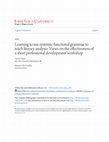
Teaching English Language Arts to English Language Learners, 2016
As students' academic language ability grows, they are expected to move from summarizing or retel... more As students' academic language ability grows, they are expected to move from summarizing or retelling works of literature to studying texts critically. With this comes the demand for more developed literacy skills or, as those working from a systemic functional linguistic perspective would argue, an increase in the students' resources for making meaning in an ever-widening variety of contexts (Derewianka, 2001). English language arts (ELA) teachers in the United States today are challenged with the task of developing this literacy to meet Common Core State Standards (National Governors Association Center for Best Practices and Council of Chief State School Officers, 2010). Specific standards for literacy development include teaching students to understand how to uncover what is important in a text and to describe and argue the explicit evidence and inferences that support their opinions as well as to analyze the connection between an author's word choice and the meaning of the text. Throughout the schooling years, teachers are required by the Common Core to move students from enjoying literature in the younger grades to studying literature from middle school onwards, and in doing so teachers must aim to develop students' ability to argue and support ideas and opinions in literature classrooms as well as develop literacy skills across all areas of the curriculum. In other words, ELA teachers have the challenging task of helping students engage in literature while also developing literacy skills for use across the curriculum. This can be an especially ambitious task when their students are also learning the English language. Disciplines Educational Assessment, Evaluation, and Research | Language and Literacy Education Comments This is a manuscript of a chapter published as Slater, T., & McCrocklin, S. (2016). Learning to use simplified systemic functional grammar to teach literary analysis. In L.C. de Oliveira & M. Shoffner (Eds.), ELA teachers and ELL students: Preparing English language arts teachers to teach English language learners. London, UK:
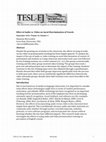
Despite the growing use of media in the classroom, the effects of using of audio versus video in ... more Despite the growing use of media in the classroom, the effects of using of audio versus video in pronunciation teaching has been largely ignored. To analyze the impact of the use of audio or video training on aural discrimination of vowels, 61 participants (all students at a large American university) took a pre-‐test followed by two training sessions on a vowel contrast (/i/-‐/ɪ/). One group received audio training and the other group received video training. The groups then took a post-‐test and delayed post-‐test to determine the impact of the training. Students’ reactions to the two training types were also obtained through a questionnaire. Results showed that while both groups improved significantly from the pre-‐test to both post-‐tests, there was no statistically significant difference between the video and audio groups. Results show that reactions were more favorable to the video training.
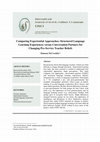
Research has shown that language teachers’ beliefs are often difficult to change through educatio... more Research has shown that language teachers’ beliefs are often difficult to change through education. Experiential learning may help, but more research is needed to understand how experiential approaches shape perceptions. This study compares two approaches, conversation partners (CONV) and structured language learning experiences (SLLE), integrated into a course in language acquisition. Participants (n = 32) completed a pre- and post-questionnaire that included: demographic questions, Likert scales on beliefs, ranking of second language acquisition (SLA) factors, and open-ended questions. Results showed differences from pre- to post-questionnaire for both groups for four Likert scale items (e.g., the importance of exact pronunciation) and six language learning factors (e.g., motivation). Further, both groups grew to recognize more factors. Slight differences emerged between groups on two items, the importance of intelligence and dominance in SLA. Qualitative analysis showed that, wh...
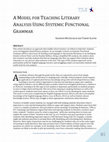
This article introduces an approach that middle-school teachers can follow to help their students... more This article introduces an approach that middle-school teachers can follow to help their students carry out linguistic-based literary analyses. As an example, it draws on Systemic Functional Grammar (SFG) to show how J.K. Rowling used language to characterize Hermione as an intelligent female in Harry Potter and the Deathly Hallows. Using a simplified SFG analysis, the authors show how teachers can help students find and use language data that can support their intuition about characters or can uncover other patterns in the text. This type of SFG analysis approach can be particularly useful for English language learners and struggling readers as it provides students with useful tools for text analysis. Disciplines Bilingual, Multilingual, and Multicultural Education | Educational Methods | Language and Literacy Education Comments This article is published as McCrocklin, S., & Slater, T. (2017). A model for teaching literature using systemic functional grammar. Texas Journal of Liter...
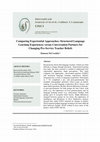
Research has shown that language teachers’ beliefs are often difficult to change through educatio... more Research has shown that language teachers’ beliefs are often difficult to change through education. Experiential learning may help, but more research is needed to understand how experiential approaches shape perceptions. This study compares two approaches, conversation partners (CONV) and structured language learning experiences (SLLE), integrated into a course in language acquisition. Participants (n = 32) completed a preand post-questionnaire that included: demographic questions, Likert scales on beliefs, ranking of second language acquisition (SLA) factors, and open-ended questions. Results showed differences from preto post-questionnaire for both groups for four Likert scale items (e.g., the importance of exact pronunciation) and six language learning factors (e.g., motivation). Further, both groups grew to recognize more factors. Slight differences emerged between groups on two items, the importance of intelligence and dominance in SLA. Qualitative analysis showed that, while C...

New Horizons in English Studies
Today, technology plays a pivotal role in language teaching and many teachers are expected to int... more Today, technology plays a pivotal role in language teaching and many teachers are expected to integrate technology into their instruction. Although studies have shown positive results from the incorporation of technology into language learning, many studies have also raised concerns about lack of teacher preparedness to teach with technology. Grounded in the TPACK Framework developed by Koehler and Mishra (2006), the present study examines teachers’ technology literacy for supporting technology-enhanced English as a Foreign Language (EFL) instruction in Maluku, Eastern Indonesia. The participants (n=43) were EFL teachers at public high schools and vocational high schools in Maluku. The data were collected using an online TPACK questionnaire (Schmidt et al. 2009) and semi-structured interviews with EFL teachers. The findings showed teachers’ awareness of the significance of technology use in their EFL instruction. Teachers acknowledged a handful of tools already deployed to improve E...
Issues in Applying SLA Theories toward Reflective and Effective Teaching
Knowing how to teach pronunciation is an essential skill for any language teacher. However, Engli... more Knowing how to teach pronunciation is an essential skill for any language teacher. However, English language teachers often report feeling uncertain about or inadequate in teaching pronunciation . Rarely do teachers say they feel inadequate teaching grammar or other language features or skills. But pronunciation is different. This is why it is especially important to consider what makes an effective pronunciation teacher.
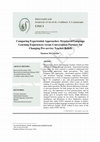
International Journal of Society, Culture, & Langauge, 2020
Research has shown that language teachers' beliefs are often difficult to change through educatio... more Research has shown that language teachers' beliefs are often difficult to change through education. Experiential learning may help, but more research is needed to understand how experiential approaches shape perceptions. This study compares two approaches, conversation partners (CONV) and structured language learning experiences (SLLE), integrated into a course in language acquisition. Participants (n = 32) completed a pre-and post-questionnaire that included: demographic questions, Likert scales on beliefs, ranking of second language acquisition (SLA) factors, and open-ended questions. Results showed differences from pre-to post-questionnaire for both groups for four Likert scale items (e.g., the importance of exact pronunciation) and six language learning factors (e.g., motivation). Further, both groups grew to recognize more factors. Slight differences emerged between groups on two items, the importance of intelligence and dominance in SLA. Qualitative analysis showed that, while CONV reported no changes in beliefs, SLLE reported finding language learning to be more difficult than believed. Further, SLLE wished to have more of the project, while CONV did not.
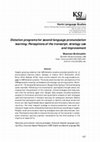
Konin Language Studies, 2019
Despite growing evidence that ASR-dictation practice provides benefits for L2 pronunciation learn... more Despite growing evidence that ASR-dictation practice provides benefits for L2 pronunciation learners (Liakin, Cardoso, & Liakina, 2014; McCrocklin, 2019; Mroz, 2018, Wallace, 2016), there is little research into the ways students engage in ASR-dictation practice. This study examines learners' perceptions of the ASR-generated transcript as feedback and strategy use during practice. Participants (N = 15) dictated 60 sentences to Google Voice Typing in Drive while being audio recorded. Following a mis-transcription, participants thought-aloud, discussing their interpretation of the transcript, utilized strategies and resources, and tried the sentence again with Google. Data analysis included qualitative analysis of think-aloud comments and quantitative analysis of both strategies used and improvement in dictation accuracy for subsequent attempts. Results showed that participants used the transcript to identify individual words with errors, but also hypothesized about segmentals and articulatory features causing errors. The most frequent strategy to improve production was covert rehearsal of target words, followed by listening to dictionary recordings of targets. Possibly novel pronunciation learning strategies were also documented, however. Participants were able to improve the accuracy of the transcript in subsequent attempts, earning a perfect transcription by the third attempt in the majority of cases (91%).
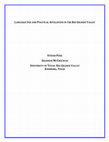
NAAAS 2016 Special Events Monograph- Proceedings from the International Research Forum of the National Association of Hispanic and Latino Studies, 2018
Research has suggested that there may be a connection between pronoun usage and political ag... more Research has suggested that there may be a connection between pronoun usage and political agenda/ideology (Vukovic, 2012). However, most of the research done on language use and political ideology has focused on political leaders and prominent revolutionaries. However, there is reason to think that regular citizens may also alter their language based on beliefs and affiliations. Pennebaker (2011) showed that a consistent use of the same pronoun throughout speech or text can help identify an individual's emotional state. Pennebaker did not examine pronoun usage in relationship to political ideology. In our study, we try to ascertain whether or not there is a connection between a subjects' political party choice or ideology and their use of pronouns. For example, is a person that uses “I” more frequently more inclined to a certain political party/ideology such as libertarianism?
For this study, we focused on Hispanics living in South Texas. Participants (n=30) took an online survey that asked six demographic questions and three questions about political affiliation. The last two questions of the survey asked participants to provide two writing samples: 1) explaining the most important meal of the day and 2) explaining the participant's political affiliation. In the analysis, we calculated the ratio of pronouns used to non-pronouns and looked for correlations between pronoun usage and political thought.
Preliminary findings show that participants that identified as Republican relied heavily on the pronoun “I” in describing reasons for their political affiliation. On the other hand, participants that identified as Democrats used a combination of “I” and “they,” in which “they” referred to the Democratic Party. Interestingly, the participants that reported no party affiliation did not follow the same patterns. Responses from unaffiliated participants used the pronoun “you” or referred exclusively to a particular party. There were no uses of “I” within the politically unaffiliated responses.
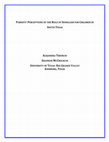
NAAAS 2016 Special Events Monograph- Proceedings from the International Research Forum of the National Association of Hispanic and Latino Studies, 2018
This paper presentation examines beliefs among parents about Spanglish in the Rio Grande Val... more This paper presentation examines beliefs among parents about Spanglish in the Rio Grande Valley (RGV) in South Texas, an area of rich linguistic diversity. Little research has been conducted about perceptions of Spanglish and what role it should have for children in this area, and research is needed to understand the societal role of Spanglish for this predominantly Hispanic area.
Spanglish is used as a common way to refer to the linguistic phenomena of code-switching between English and Spanish (Antonio Martinez, 2010; Gardner-Chloros, 2009). Beyond just the linguistic features, Rell and Rothman (2007) described the symbolic meaning of Spanglish as a way for second-generation Mexican-Americans who “live between two cultures” (p. 245), to construct and reflect their identity. Research has shown that children that are raised with two languages are likely to code-switch from an early age (Cantone, 2007). Their mixing of languages is likely to be less structured and rule-governed that in adults, however (Cantone, 2007). Some children may not even be aware of when or if they are code-switching (Antonio Martinez, 2014).
While linguistic research in the RGV has examined Spanish language use and maintenance (Amastae, 1982; Anderson-Mejías, 2005), more research is needed on Spanglish use in the Rio Grande Valley of Lower South Texas. In particular, how do bilingual parents in the Rio Grande Valley of South Texas perceive the role of Spanglish for their children? In what ways do they perceive it as beneficial? What methods or actions do parents use (or plan to use) to ensure that their children use or avoid Spanglish?
Spanish-English bilinguals that lived in the Rio Grande Valley of South Texas were recruited to take an online survey. This analysis focused on participants who also reported having children (n=61). Participants ranged in age from 21-63 and had achieved varying levels of education. The survey included 44 questions. Questions, which utilized multiple question formats (open text boxes, multiple choice, Likert scale), determined demographic information, perceptions of Spanglish, and desired role of Spanglish in the household.
Most of the participants agreed or strongly agreed that they want their children to be bilingual (95%). Eighty-five percent of participants agreed with the statement that they use or plan to use English and Spanish at home. Around half (45%) also reported that they want to enroll them in a bilingual program. There is noticeably less support for Spanglish, however. Parents were generally split on whether they wanted their children to speak Spanglish. However, 22% thought that Spanglish doesn’t have any benefit for their children. The most recurrent concern about children using Spanglish is that it is not the proper way to speak English or Spanish. Further, 75% didn’t want Spanglish to be taught at school while 49% of the participants intended to correct their children when they speak Spanglish at home. The majority of participants believed that their children will not be able to succeed if they speak Spanglish. For 32% of the parents, Spanglish has no relevance in the United States or its future. Around a third of the parents commented that the benefits of Spanglish for their children are the increased ability to communicate with the community or establish their own identity. For many of these parents, 26% of participants, Spanglish has a future and they believe that it should be taught as it is a cultural issue.
NAAAS 2015 Special Events Monograph- Proceedings from the International Research Forum of the National Association of Hispanic and Latino Studies, 2016
This paper examines preliminary results on a research study about Spanglish in the Rio Grande Val... more This paper examines preliminary results on a research study about Spanglish in the Rio Grande Valley (RGV) in South Texas, an area of rich linguistic diversity. Little research has been conducted about perceptions of Spanglish in this area and research is needed to understand the societal role of Spanglish for this predominantly Hispanic area.
Full reference information:
McCrocklin, S. & Tiburcio, A. (2016). Spanglish in the Rio Grande Valley of South Texas. In J. Berry (Ed.). Special Events Monograph of the NAAAS and Affiliates: Proceedings from the International Research Forum of the National Association of Hispanic and Latino Studies (pp. 308-328). South Padre Island, TX: University of Texas- Rio Grande Valley.
Canadian Modern Language Review, 2016
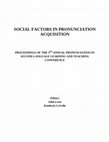
Jennifer Jenkins, in numerous publications (e.g., 2000; 2002; 2006), has proposed a syllabus for ... more Jennifer Jenkins, in numerous publications (e.g., 2000; 2002; 2006), has proposed a syllabus for teaching English pronunciation that takes into consideration the new role of English as an International Language (EIL), or English as a Lingua Franca (ELF). In these publications, she proposes a “lingua franca core” in which some pronunciation features are considered core, or necessary for intelligibility, and some features are considered non-core, or not necessary for intelligibility. She proposes that word stress not be considered part of the core for three reasons: because word stress does not pose intelligibility issues, because word stress is too complex to be teachable, and because word stress patterns are variable among Native Speaker (NS) dialects of English. This paper will argue from other research that each of these issues may be seen as an argument for rather than against word stress being considered a core feature, thus suggesting a more important role for word stress in ELF.

Uploads
Papers by Shannon McCrocklin
For this study, we focused on Hispanics living in South Texas. Participants (n=30) took an online survey that asked six demographic questions and three questions about political affiliation. The last two questions of the survey asked participants to provide two writing samples: 1) explaining the most important meal of the day and 2) explaining the participant's political affiliation. In the analysis, we calculated the ratio of pronouns used to non-pronouns and looked for correlations between pronoun usage and political thought.
Preliminary findings show that participants that identified as Republican relied heavily on the pronoun “I” in describing reasons for their political affiliation. On the other hand, participants that identified as Democrats used a combination of “I” and “they,” in which “they” referred to the Democratic Party. Interestingly, the participants that reported no party affiliation did not follow the same patterns. Responses from unaffiliated participants used the pronoun “you” or referred exclusively to a particular party. There were no uses of “I” within the politically unaffiliated responses.
Spanglish is used as a common way to refer to the linguistic phenomena of code-switching between English and Spanish (Antonio Martinez, 2010; Gardner-Chloros, 2009). Beyond just the linguistic features, Rell and Rothman (2007) described the symbolic meaning of Spanglish as a way for second-generation Mexican-Americans who “live between two cultures” (p. 245), to construct and reflect their identity. Research has shown that children that are raised with two languages are likely to code-switch from an early age (Cantone, 2007). Their mixing of languages is likely to be less structured and rule-governed that in adults, however (Cantone, 2007). Some children may not even be aware of when or if they are code-switching (Antonio Martinez, 2014).
While linguistic research in the RGV has examined Spanish language use and maintenance (Amastae, 1982; Anderson-Mejías, 2005), more research is needed on Spanglish use in the Rio Grande Valley of Lower South Texas. In particular, how do bilingual parents in the Rio Grande Valley of South Texas perceive the role of Spanglish for their children? In what ways do they perceive it as beneficial? What methods or actions do parents use (or plan to use) to ensure that their children use or avoid Spanglish?
Spanish-English bilinguals that lived in the Rio Grande Valley of South Texas were recruited to take an online survey. This analysis focused on participants who also reported having children (n=61). Participants ranged in age from 21-63 and had achieved varying levels of education. The survey included 44 questions. Questions, which utilized multiple question formats (open text boxes, multiple choice, Likert scale), determined demographic information, perceptions of Spanglish, and desired role of Spanglish in the household.
Most of the participants agreed or strongly agreed that they want their children to be bilingual (95%). Eighty-five percent of participants agreed with the statement that they use or plan to use English and Spanish at home. Around half (45%) also reported that they want to enroll them in a bilingual program. There is noticeably less support for Spanglish, however. Parents were generally split on whether they wanted their children to speak Spanglish. However, 22% thought that Spanglish doesn’t have any benefit for their children. The most recurrent concern about children using Spanglish is that it is not the proper way to speak English or Spanish. Further, 75% didn’t want Spanglish to be taught at school while 49% of the participants intended to correct their children when they speak Spanglish at home. The majority of participants believed that their children will not be able to succeed if they speak Spanglish. For 32% of the parents, Spanglish has no relevance in the United States or its future. Around a third of the parents commented that the benefits of Spanglish for their children are the increased ability to communicate with the community or establish their own identity. For many of these parents, 26% of participants, Spanglish has a future and they believe that it should be taught as it is a cultural issue.
Full reference information:
McCrocklin, S. & Tiburcio, A. (2016). Spanglish in the Rio Grande Valley of South Texas. In J. Berry (Ed.). Special Events Monograph of the NAAAS and Affiliates: Proceedings from the International Research Forum of the National Association of Hispanic and Latino Studies (pp. 308-328). South Padre Island, TX: University of Texas- Rio Grande Valley.
For this study, we focused on Hispanics living in South Texas. Participants (n=30) took an online survey that asked six demographic questions and three questions about political affiliation. The last two questions of the survey asked participants to provide two writing samples: 1) explaining the most important meal of the day and 2) explaining the participant's political affiliation. In the analysis, we calculated the ratio of pronouns used to non-pronouns and looked for correlations between pronoun usage and political thought.
Preliminary findings show that participants that identified as Republican relied heavily on the pronoun “I” in describing reasons for their political affiliation. On the other hand, participants that identified as Democrats used a combination of “I” and “they,” in which “they” referred to the Democratic Party. Interestingly, the participants that reported no party affiliation did not follow the same patterns. Responses from unaffiliated participants used the pronoun “you” or referred exclusively to a particular party. There were no uses of “I” within the politically unaffiliated responses.
Spanglish is used as a common way to refer to the linguistic phenomena of code-switching between English and Spanish (Antonio Martinez, 2010; Gardner-Chloros, 2009). Beyond just the linguistic features, Rell and Rothman (2007) described the symbolic meaning of Spanglish as a way for second-generation Mexican-Americans who “live between two cultures” (p. 245), to construct and reflect their identity. Research has shown that children that are raised with two languages are likely to code-switch from an early age (Cantone, 2007). Their mixing of languages is likely to be less structured and rule-governed that in adults, however (Cantone, 2007). Some children may not even be aware of when or if they are code-switching (Antonio Martinez, 2014).
While linguistic research in the RGV has examined Spanish language use and maintenance (Amastae, 1982; Anderson-Mejías, 2005), more research is needed on Spanglish use in the Rio Grande Valley of Lower South Texas. In particular, how do bilingual parents in the Rio Grande Valley of South Texas perceive the role of Spanglish for their children? In what ways do they perceive it as beneficial? What methods or actions do parents use (or plan to use) to ensure that their children use or avoid Spanglish?
Spanish-English bilinguals that lived in the Rio Grande Valley of South Texas were recruited to take an online survey. This analysis focused on participants who also reported having children (n=61). Participants ranged in age from 21-63 and had achieved varying levels of education. The survey included 44 questions. Questions, which utilized multiple question formats (open text boxes, multiple choice, Likert scale), determined demographic information, perceptions of Spanglish, and desired role of Spanglish in the household.
Most of the participants agreed or strongly agreed that they want their children to be bilingual (95%). Eighty-five percent of participants agreed with the statement that they use or plan to use English and Spanish at home. Around half (45%) also reported that they want to enroll them in a bilingual program. There is noticeably less support for Spanglish, however. Parents were generally split on whether they wanted their children to speak Spanglish. However, 22% thought that Spanglish doesn’t have any benefit for their children. The most recurrent concern about children using Spanglish is that it is not the proper way to speak English or Spanish. Further, 75% didn’t want Spanglish to be taught at school while 49% of the participants intended to correct their children when they speak Spanglish at home. The majority of participants believed that their children will not be able to succeed if they speak Spanglish. For 32% of the parents, Spanglish has no relevance in the United States or its future. Around a third of the parents commented that the benefits of Spanglish for their children are the increased ability to communicate with the community or establish their own identity. For many of these parents, 26% of participants, Spanglish has a future and they believe that it should be taught as it is a cultural issue.
Full reference information:
McCrocklin, S. & Tiburcio, A. (2016). Spanglish in the Rio Grande Valley of South Texas. In J. Berry (Ed.). Special Events Monograph of the NAAAS and Affiliates: Proceedings from the International Research Forum of the National Association of Hispanic and Latino Studies (pp. 308-328). South Padre Island, TX: University of Texas- Rio Grande Valley.